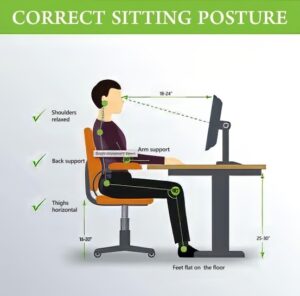. Good posture is a position in which the body is aligned in a way that puts the least amount of strain on the muscles, joints, and ligaments. It involves maintaining a balance between different parts of the body, so that the spine, shoulders, and hips are properly aligned.
Good posture is a position in which the body is aligned in a way that puts the least amount of strain on the muscles, joints, and ligaments. It involves maintaining a balance between different parts of the body, so that the spine, shoulders, and hips are properly aligned.
What is good posture and what does it look like?
- The head is balanced directly over the shoulders, without leaning forward or backward.
- The shoulders are relaxed and level, not hunched or rounded.
- The spine is aligned in its natural curves, with the neck slightly curved inward, the upper back slightly curved outward, and the lower back slightly curved inward.
- The pelvis is in a neutral position, with the hips level and the tailbone pointing downward.
- The knees are slightly bent and in line with the feet.
- The feet are flat on the ground, with the weight distributed evenly on both feet.
Maintaining good posture throughout the day can help reduce the risk of developing a range of health problems, including back and neck pain, headaches, and fatigue. It can also improve breathing, digestion, and circulation, as well as increase energy levels and self-confidence.
What are the benefits of having good sitting posture?
Maintaining good posture has many benefits for your health and well-being, including:
- Reduced back and neck pain. Good posture helps to reduce strain on the muscles and joints of the spine, which can alleviate back and neck pain.
- Improved breathing and digestion. Good posture helps to open up the chest and abdomen, allowing for better breathing and digestion.
- Increased energy levels. Good posture helps to reduce muscle tension and fatigue, which can lead to increased energy levels and improved concentration.
- Better balance and coordination. Good posture helps to improve balance and coordination, which can help reduce the risk of falls and injuries.
- Improved self-confidence. Good posture can help improve your appearance and make you feel more confident in social situations.
- Reduced headaches. Poor posture can cause tension headaches and migraines, while good posture can help reduce the frequency and severity of these headaches.
- Improved circulation. Good posture helps to improve circulation by reducing pressure on blood vessels and nerves, which can help reduce the risk of varicose veins and deep vein thrombosis.
Tips to help you improve your sitting posture
- Strengthen your core. A strong core can help support your spine and improve your posture. Exercises such as planks, side planks, and bridges can help strengthen your core muscles.
- Stretch regularly. Tight muscles can pull your body out of alignment and contribute to poor posture. Stretching regularly can help keep your muscles flexible and reduce muscle tension. Consider incorporating stretches for your chest, shoulders, neck, and hips.
- Sit correctly. When sitting, keep your feet flat on the ground, and your back straight. Make sure that your hips are pushed back against the chair, and use a cushion or a rolled-up towel to support your lower back.
- Stand tall. When standing, make sure that your shoulders are back and down, your chin is parallel to the floor, and your knees are slightly bent. Keep your weight evenly distributed on both feet.
- Take frequent breaks. If you sit for long periods, make sure to take regular breaks to stand up and move around. This can help reduce the strain on your back and neck muscles.
- Use ergonomic equipment. Consider using ergonomic chairs, keyboards, and mouse pads to help support your body in the correct posture while working.
- Get regular exercise. Regular exercise can help improve your posture by strengthening your muscles and improving your flexibility.
Improving your posture can be achieved through a combination of exercises, lifestyle changes, and conscious awareness of your body positioning throughout the day. Remember that improving your posture is a gradual process that requires consistent effort and awareness. By implementing these tips into your daily routine, you can begin to improve your posture over time.
